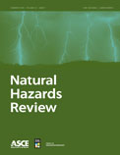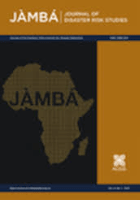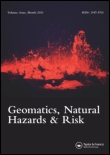
Natural Hazards Review
Scope & Guideline
Unraveling the Impact of Nature on Humanity
Introduction
Aims and Scopes
- Natural Hazard Assessment:
The journal emphasizes comprehensive assessments of various natural hazards, including floods, earthquakes, hurricanes, and landslides, utilizing both quantitative and qualitative methodologies. - Disaster Resilience and Recovery:
Research on strategies for enhancing community resilience and effective recovery from disasters is a core focus, including studies on infrastructure, social systems, and economic impacts. - Climate Change Impacts and Adaptation:
The journal frequently addresses the implications of climate change on natural hazards and resilience, promoting innovative adaptation strategies and risk management frameworks. - Technological Innovations in Risk Management:
There is a consistent emphasis on the application of advanced technologies such as machine learning, GIS, and remote sensing in assessing and managing disaster risks. - Interdisciplinary Collaboration:
The journal promotes research that involves collaboration across disciplines, integrating insights from engineering, social sciences, public policy, and environmental science to address complex disaster challenges.
Trending and Emerging
- Machine Learning and Data Analytics:
The use of machine learning and advanced data analytics techniques is rapidly increasing, showcasing their potential in predicting hazards, assessing risks, and optimizing disaster response. - Community Resilience and Social Vulnerability:
There is a growing emphasis on understanding community resilience and social vulnerability, highlighting the importance of social dynamics in disaster preparedness and recovery. - Climate Change Adaptation Strategies:
Research on adaptation strategies in response to climate change is trending, with a focus on innovative practices and policies to mitigate climate-related risks. - Integrated Disaster Risk Management:
An emerging theme is the integration of various risk management strategies, including economic, environmental, and social dimensions, to create comprehensive disaster management frameworks. - Technological Advancements in Early Warning Systems:
Research is increasingly focusing on enhancing early warning systems through technological innovations, including the use of mobile applications and social media for real-time communication.
Declining or Waning
- Traditional Risk Assessment Methods:
There appears to be a waning focus on conventional risk assessment methodologies without integration of modern technology, as newer approaches utilizing machine learning and data analytics gain traction. - Purely Engineering-Focused Studies:
Research that solely emphasizes engineering solutions without considering social, economic, or environmental contexts is becoming less common, reflecting a shift towards more holistic approaches. - Historical Case Studies:
There is a noticeable decline in the frequency of publications solely based on historical case studies, as the journal increasingly favors contemporary and forward-looking research that addresses current challenges. - Single-Hazard Studies:
The scope of research is moving away from single-hazard studies to more comprehensive multihazard assessments, indicating a decline in interest in isolated hazard analyses. - Focus on Localized Issues:
The journal is expanding its geographical focus, suggesting a decline in papers that only address localized issues without broader implications or applicability.
Similar Journals

Progress in Disaster Science
Fostering Global Collaboration in Disaster ScienceProgress in Disaster Science, published by ELSEVIER, is a prestigious open-access journal that has been advancing the field of disaster research since its inception in 2019. With an ISSN of 2590-0617, the journal has quickly established itself as a leading resource, recognized for its impact across various related disciplines, as evidenced by its impressive Q1 rankings in 2023 in categories such as Earth and Planetary Sciences, Environmental Science, Geography, Planning and Development, and Safety Research. This journal publishes cutting-edge research that aims to enhance understanding and management of disaster risks, resilience, and recovery processes. Additionally, the journal's accessibility ensures that important findings are disseminated widely, fostering collaboration among researchers, professionals, and students globally. Positioned under the umbrella of critical environmental and safety insights, Progress in Disaster Science plays a pivotal role in shaping the discourse surrounding disaster management and preparedness in today's rapidly changing world.

Journal of Mountain Science
Elevating Research on Sustainable Mountain DevelopmentThe Journal of Mountain Science, published by SCIENCE PRESS, is a distinguished academic journal dedicated to advancing the understanding of mountain environments and their significance in various scientific domains. With an ISSN of 1672-6316 and an E-ISSN of 1993-0321, this journal has carved a niche in the field of Earth sciences, earning a commendable Q2 ranking in categories such as Earth-Surface Processes, Geography, Planning and Development, and Geology, as well as a Q3 ranking in Global and Planetary Change. Since its inception in 2007, the journal has been pivotal in fostering interdisciplinary research that addresses critical environmental issues, making it an essential resource for researchers, professionals, and students alike. While currently not offering open access, it provides valuable insights into areas including nature conservation and landscape management, with a focus on the unique challenges faced by mountainous regions. Located in Beijing, China, the Journal of Mountain Science continues to promote scholarly discourse that contributes to the sustainable development of mountain communities and ecosystems until 2024 and beyond.

Bulletin of Geophysics and Oceanography
Pioneering Research for a Deeper Understanding of Earth SystemsBulletin of Geophysics and Oceanography is a distinguished open-access journal published by the IST NAZIONALE DI OCEANOGRAFIA E DI GEOFISICA in Italy, dedicated to advancing knowledge in the multidisciplinary fields of geophysics, oceanography, and related engineering disciplines. Since its inception in 2000, the journal has been pivotal in providing a platform for innovative research and comprehensive reviews that support the scientific community's efforts to understand Earth's dynamic systems. With an ISSN of 2785-339X and an E-ISSN of 2785-2970, the journal operates under an open-access model, ensuring that groundbreaking discoveries reach a wider audience without barriers. The Bulletin is categorized in the Q4 quartile for the years 2023 in Computers in Earth Sciences, Geophysics, Geotechnical Engineering and Engineering Geology, and Oceanography. It ranks within the 41st and 37th percentiles in geophysics and oceanography respectively, highlighting its emerging influence in the scientific community. The journal welcomes submissions that span across fundamental research and applied sciences, aiming to foster collaboration among researchers, professionals, and students, thereby contributing to the sustainable management of oceanic and terrestrial resources.

Jamba-Journal of Disaster Risk Studies
Exploring Solutions for a Safer Tomorrow.Jamba-Journal of Disaster Risk Studies, published by AOSIS, serves as a vital resource in the fields of management, monitoring, policy, law, and safety research, with an ISSN of 1996-1421 and an E-ISSN of 2072-845X. Since its establishment as an Open Access journal in 2006, Jamba has dedicated itself to disseminating high-quality research that informs and enhances disaster risk management practices, particularly within the South African context and beyond. With a robust Impact Factor and acknowledgement in the Q2 and Q3 quartiles across critical categories in 2023, Jamba ranks favorably in Scopus, notably Rank #50/109 in Social Sciences (Safety Research) and Rank #218/399 in Environmental Science (Management, Monitoring, Policy and Law). The journal's convergence over the years—from 2013 to 2024—signals its commitment to adapting contemporary challenges in disaster risk studies. Scholars and practitioners are encouraged to explore Jamba as a go-to platform for innovative insights and collaborative discussions that impact policy-making and practical applications in disaster risk reduction.

Geomatics Natural Hazards & Risk
Transforming Data into Solutions for Natural HazardsGeomatics Natural Hazards & Risk, published by TAYLOR & FRANCIS LTD, is a premier open-access journal that has been at the forefront of interdisciplinary research since 2010, addressing critical issues related to natural hazards and environmental risk management. With an impressive impact factor and ranking in the Q1 quartile in both Earth and Planetary Sciences and Environmental Science categories, this journal serves as a vital platform for researchers, professionals, and students dedicated to advancing knowledge in these fields. The journal's commitment to open access since 2016 ensures that its high-quality research is readily available to a global audience, fostering collaboration and innovation. Located in the United Kingdom, Geomatics Natural Hazards & Risk encompasses a broad scope of studies including geospatial technologies, risk assessment methodologies, and the societal impacts of natural disasters, making it an essential resource for anyone involved in the investigation and mitigation of natural hazards.

Cuadernos de Investigacion Geografica
Bridging Disciplines in Geography and Environmental AnalysisCuadernos de Investigacion Geografica, published by UNIV RIOJA, SERV PUBLICACIONES, stands as a premier open-access journal dedicated to advancing knowledge in the fields of geography, environmental science, and earth sciences. Since its inception in 1983, this journal has fostered innovative research and critical discourse, currently holding a distinguished position in Scopus with impressive quartile rankings, including Q2 in both Earth and Planetary Sciences, and Geography, Planning and Development, reflecting its impact and relevance. With an aim to present high-quality, peer-reviewed articles that contribute to the understanding of our planet and its systems, Cuadernos de Investigacion Geografica welcomes submissions from researchers, professionals, and students alike, fostering a collaborative environment that spans across diverse geographical contexts. Operating from its hub in Logroño, Spain, this journal continues to be a vital resource for anyone engaged in geographical research and environmental analysis, providing open access to enhance knowledge sharing and innovation in these dynamic fields.

NATURAL HAZARDS AND EARTH SYSTEM SCIENCES
Connecting Science, Policy, and Practice for a Safer FutureNATURAL HAZARDS AND EARTH SYSTEM SCIENCES, an esteemed journal published by COPERNICUS GESELLSCHAFT MBH, focuses on the interdisciplinary study of natural hazards and their impact on Earth system processes. Since its inception in 2001, this Open Access journal has been instrumental in disseminating high-quality research, facilitating a global exchange of knowledge in the field of Earth and Planetary Sciences. With an impressive Q1 ranking in its category and a commendable Scopus Rank of 22 out of 195, it serves as a crucial platform for researchers striving to understand and mitigate the risks associated with natural hazards. The journal is committed to enhancing environmental resiliency and promoting sustainable practices, making it essential reading for scholars, practitioners, and policymakers dedicated to tackling the challenges posed by our dynamic planet. Based in Germany, at BAHNHOFSALLEE 1E, GOTTINGEN 37081, it continues to support the growing body of knowledge that bridges scientific research with practical application.

CANADIAN JOURNAL OF CIVIL ENGINEERING
Pioneering Research in Civil and Structural EngineeringCanadian Journal of Civil Engineering, published by Canadian Science Publishing, serves as a premier platform for the dissemination of innovative research and development in the fields of civil and structural engineering, as well as environmental science. Established in 1971, this journal maintains a robust reputation, achieving a Q3 ranking in both civil engineering and general environmental science categories as of 2023. While it does not currently offer open access, the journal is accessible to a wide audience of researchers, professionals, and students who are keen to stay abreast of the latest advancements in civil engineering practices. With a significant number of yearly publications and a committed editorial board, the Canadian Journal of Civil Engineering contributes to the foundational knowledge and practical applications in the engineering community, thereby playing a critical role in addressing contemporary challenges in civil infrastructure and environmental sustainability.

All Earth
Fostering Interdisciplinary Dialogue on Environmental IssuesAll Earth is an esteemed open-access journal published by Taylor & Francis Ltd, dedicated to multidisciplinary research in the fields of Earth and Planetary Sciences, Global and Planetary Change, as well as Management, Monitoring, Policy, and Law. Since its inception in 2021, All Earth has swiftly positioned itself in the academic community, achieving notable rankings such as Q2 in Earth and Planetary Sciences and Q3 in related fields, showcasing its commitment to high-quality interdisciplinary scholarship. Researchers and professionals can benefit from its accessible content, which contributes to the ongoing discourse on critical environmental issues and innovative solutions for sustainable development. The journal is based in the United Kingdom and continues to be a vital source of information and inspiration for students and scholars aiming to tackle the pressing challenges of our planet through rigorous scientific inquiry and policy analysis.

Journal of Indian Geophysical Union
Unveiling Earth's Processes through Rigorous ResearchThe Journal of Indian Geophysical Union, published by the Indian Geophysical Union (IGU), serves as a vital platform for disseminating research in the field of geophysics. With the ISSN 0257-7968, this journal primarily focuses on studies related to geophysical sciences, including but not limited to, seismicity, environmental geophysics, and geodynamics, contributing to a better understanding of the Earth's processes. The journal is committed to quality research and aims to foster a collaborative environment for researchers, professionals, and students in India and internationally. Although currently not designated as an Open Access publication, it plays an essential role in connecting academia with practical applications in geophysical research. Based in Hyderabad, India, the Journal of Indian Geophysical Union continues to be an essential resource for those seeking to expand their knowledge and engage with the latest findings in geophysics.